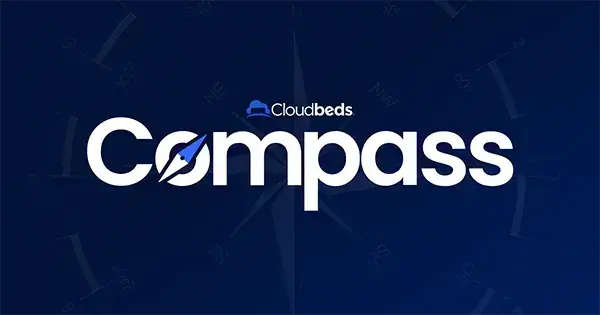Aligning your marketing
budget with revenue goals
Hoteliers are constantly asked to do more with less. But when it comes to marketing, less often leads to less—less visibility, fewer bookings, and weaker revenue.
Despite its impact, marketing remains one of the most under-planned areas of hotel operations. For starters, many hotels simply don’t invest enough. According to Gartner’s 2024 Marketing Budget Benchmark for Travel & Hospitality, marketing budgets increased from 7.3% in 2023 to 8.4% of total revenue in 2024.
That’s still well below the hospitality industry’s 11% average in 2019, and just at the lower end of what’s considered best practice, according to Ben Lloyd, Director of Digital Marketing Services at Cloudbeds. He says, “Hotels should allocate 8-15% of annual revenue to marketing. If your goal is to hit a million dollars in revenue this year, 10% means you should be spending around $100,000. New or rebranded properties should spend closer to 15%.”
But it’s not just about spending more. To maximize ROI, hotels need to be strategic. That starts with a hotel marketing budget.
A hotel marketing budget outlines how much you plan to spend to promote your property, both in total and by individual expenses. These typically fall into two categories: fixed costs (like website maintenance, marketing tools, and in-house salaries) and variable costs (such as PPC campaigns, online travel agency (OTA) commissions, and loyalty program offers). Without a budget, hotels often fall into reactive spending, responding to dips in occupancy or chasing seasonal trends without a long-term marketing strategy. As Ben puts it, “Just sitting down and creating a budget can be a giant win for most properties.” What is a hotel marketing budget?
The two pillars of an effective hotel marketing budget
A common mistake in hotel marketing is measuring success in isolation, looking only at booking volume. If you’re investing in strategies that fill rooms on high-demand nights that would’ve sold out anyway, your campaigns may look successful on paper, while doing little to grow revenue.
That’s why every hotel marketing budget should be built on two key pillars:
1. Focus on profitability, not just performance
An important question your budget should answer is: Who should we target, on which channels, and when, to increase RevPAR and total profitability?
Marketing often defaults to driving occupancy. But the real goal is to sell rooms at the highest possible rate. As Amit Popat, Cloudbeds’ Head of Machine Learning, notes at ITB Berlin, “In hotels today, we’ve got revenue managers driving room revenue goals, and marketing teams working towards return on ad spend, but that can lead to conflicts. For example, the marketing team may achieve record ROAS, but if they’ve allocated all of that revenue into high-demand days that would have sold out anyway, they’re impacting profitability.”
With profitability at the forefront, marketing teams can then start to analyze other metrics, including:
- Return on ad spend (ROAS): Revenue generated for every dollar spent on advertising.
- Cost per acquisition (CPA): The cost to acquire a new booking.
- Average booking volume: The total number of bookings across your marketing channels.
Be sure you’ve allowed campaigns enough time and data to optimize—“You can’t expect meaningful ROI from spending $35 in one week,” as Ben points out.
2. Align marketing and revenue teams
To make your marketing budget work harder, marketing and revenue teams should stop working separately and align around a shared commercial strategy.
Lori Kiel, Senior VP of Revenue Management at Pyramid Global Hospitality, echoed this on Cloudbeds’ Turndown Podcast. She says, “Since the pandemic, our costs are higher. We feel the squeeze, and the only way to do this better is to do it together. At that point, you can be sure that you are bringing the most profitable business in on the most profitable channel.” Lori goes on to say, “Marketing, sales, revenue, and ops need to move in lockstep, because every decision affects the whole.”
Building a hotel marketing budget: Key factors
There is no one ‘right’ answer to what a hotel’s marketing budget should look like. It depends on different factors:
Property size and ADR
Your pricing and room count affect how much leverage and budget you need across various marketing channels.
For example, a 10-room luxury villa charging $1,000 per night may be able to skip OTAs altogether and focus on direct channels. Meanwhile, a 100-room city hotel with a $150 ADR will need higher booking volume, which typically requires a more diversified, performance-driven marketing mix.
Guest behavior
Your marketing strategy should reflect how your guests discover and book your property.
A solo backpacker might book last-minute via an OTA on mobile, while a couple planning their honeymoon could spend weeks researching, engaging with your social media, reading reviews, and ultimately booking direct through your website.
And some guests? They might just call or walk in.
This kind of offline behavior is harder to attribute, but that doesn’t mean marketing didn’t play a role. They likely saw your brand somewhere: an ad, a social post, or a Google listing. That’s why it’s important to consider upper-funnel indicators, like branded keyword searches, ad impressions, or social engagement, in your overall strategy.
Booking windows and seasonality
Your campaigns should reflect how far in advance guests book, and when they’re most likely to travel.
Properties with long booking windows may need to advertise earlier and run longer campaigns, while short-lead markets might require flexible, always-on strategies. Be sure to factor in your high, low, and shoulder seasons, and adjust your budget accordingly to boost visibility when demand dips.
Market competitiveness
The more saturated your destination, the more you’ll need to invest to stand out, especially in paid digital channels like Google Ads and metasearch.
For example, a hotel in Manhattan will face higher cost-per-clicks (CPCs) for competitive terms like “best NYC hotels,” while a property in a smaller or emerging destination may pay significantly less for the same visibility.
Brand awareness
If your property is new or lesser known, you’ll need to invest more in top-of-funnel marketing to build trust and recognition before performance channels can be fully effective. This includes:
- Professional photography and video
- Organic and paid social media
- Content marketing and partnerships
- Influencer collaborations and earned press coverage
If your budget allows, don’t neglect brand marketing. It may not have immediate ROI like performance campaigns, but it plays a critical long-term role in driving discovery and future bookings, especially from guests who “just found you” but can’t remember how.
Where to invest your marketing dollars
To guide your budget allocation, consider the loyalty loop, an updated version of the marketing funnel. Each marketing activity should support one or more of these five stages:
- Dream (inspire potential guests exploring destinations)
- Plan (stand out during the research phase)
- Book (turn interest into direct bookings)
- Experience (enhance stays and drive upsells)
- Share (encourage reviews and repeat visits).
Use this framework to organize your marketing plan and budget into three categories:
Baseline investments (20-30%)
These foundational elements support long-term growth and boost performance of your marketing efforts:
Hotel website: Your most important asset. It must be mobile-friendly, fast, have a good user experience, and be optimized for SEO. This investment may account for website maintenance or redesign.
Social media: Build awareness and trust with authentic guest stories and destination content.
Email marketing and CRM: Collect and use guest data to deliver targeted campaigns that strengthen loyalty.
Reputation management: Actively monitor and respond to guest reviews on platforms like Google, Tripadvisor, and OTAs. Reviews ensure higher rankings across booking platforms and search results.
Performance channels (60-70%)
These are direct-response channels designed to drive conversions.
Metasearch engines: Use their cost-per-click model to capture bookings that might otherwise go to OTAs. As Ben explains, “Assuming the website is solid, I recommend implementing metasearch 100% of the time. If metasearch is working, don’t cap the spend—keep going as long as the ROI is there.”
Performance Max for Travel Goals: Google’s AI solution runs ads across the Google display network to attract high-intent website traffic.
Retargeting: Re-engage website users who didn’t book. “Retargeting only works if you have an audience, and to have an audience, you need potential guests coming to your website and booking engine,” Ben notes. “Those visitors come from your other marketing efforts, making retargeting incremental, not a volume driver.”
Experimentation (~10%)
Reserve a portion of your hotel budget for testing new ad formats, audience segments, social channels, or partnerships.
Experimentation helps you stay ahead of trends and uncover what could become your next high-performing channel.
How Cloudbeds helps hotels build more profitable budgets
Cloudbeds Digital Marketing provides a single reporting dashboard for hotels to manage performance and return on investment. Ben says, “We’re giving customers a single place to see their return on ad spend and understand what’s working.”
Because it connects directly with the Cloudbeds PMS, booking engine, and channel manager, the suite allows marketing and revenue teams to act on shared data, bridging the gap between demand generation and rate strategy.
But what truly sets the platform apart is the Cloudbeds Intelligence layer, powered by causal AI. Processing over 4 billion data points per hour, it moves beyond traditional analytics to uncover why things happen, not just what happened.

With Cloudbeds, hoteliers can move beyond siloed decision-making and build marketing budgets that are smarter, faster, and fully aligned with hotel revenue goals.


















